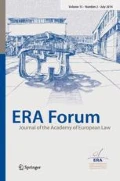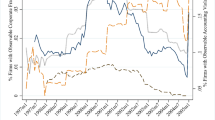Abstract
Issuers are under an obligation to disclose inside information as soon as possible according to the disclosure regime in Art 17 of the Market Abuse Regulation (MAR). The article explores what and when an issuer must disclose. The threshold for determining what constitutes inside information is low, which ensures an early application of the insider dealing regime of MAR Art 8. The low threshold includes information of an intermediate nature, which is often uncertain and consequently likely to mislead the public if disclosed. However, the disclosure regime allows for delay to avoid this.
Similar content being viewed by others
Notes
On the detrimental effect on market performance by informational asymmetries, see the literature developed since the seminal article by Akerlof [1].
Regulation (EU) No 596/2014 of the European Parliament and of the Council of 16 April 2014 on market abuse (Market Abuse Regulation) and repealing Directive 2003/6/EC of the European Parliament and of the Council and Commission Directives 2003/124/EC, 2003/125/EC and 2004/72/EC [2014] OJ L 173/1.
Directive 2014/57/EU of the European Parliament and of the Council of 16 April 2014 on criminal sanctions for market abuse (Market Abuse Directive) [2014] OJ L 173/179. The CS-MAD does not apply to all Member States, as some have reservations to harmonisation of criminal law.
The paper focuses on the disclosure obligation of issuers of securities. It should be noted that the obligation also applies to commodity derivatives and emission allowances besides securities, but these separate financial markets are not covered by this paper.
Directive 2003/6/EC of the European Parliament and of the Council of 28 January 2003 on insider dealing and market manipulation (market abuse), [2003] OJ L 96/16.
Commission [2], p. 6.
Council Directive of 13 November 1989 coordinating regulations on insider dealing (89/592) [1989] OJ L 334/30.
Proposal for a Directive of the European Parliament and of the Council on insider dealing and market manipulation (market abuse), COM(2001) 281, Brussels, 30.5.2001.
See the text on the dual notion of inside information in part 5.2.3 below.
For a more detailed analysis of the relatedness of the three measures, see Hansen [8].
For a more detailed analysis of the distinctiveness of the three measures, see Hansen [7].
See text accompanying fn. 1 above.
FCA [5].
Commission Directive 2003/124/EC of 22 December 2003 implementing Directive 2003/6/EC of the European Parliament and of the Council as regards the definition and public disclosure of inside information and the definition of market manipulation [2003] OJ L 339/70.
Commission Directive 2003/124/EC (fn. 14).
Decision of 28.6.2012 in Case C-19/11 Markus Geltl v Daimler AG, EU:C:2012:397.
Geltl (fn. 16) para. 31.
Geltl (fn. 16) para 56.
Decision of 11.3.2015 in Case 628/13 Jean-Bernard Lafonta v Autorité des marchés financiers, EU:C:2015:162.
Quote from Lafonta (fn. 17) para. 31.
Geltl (fn. 16) paras. 52–53.
Lafonta (fn. 19) para. 31, where the CJEU observes on the requirement of a precise nature: »(…) it is enough that the information be sufficiently exact or specific to constitute a basis on which to assess whether the set of circumstances or the event in question is likely to have a significant effect on the price of the financial instruments to which it relates. « This is explored in more detail in Hansen [6].
Geltl (fn. 16) para. 48.
Lafonta (fn. 19) para. 31.
Lafonta (fn. 19) para. 34.
Lafonta (fn. 19) para. 36, where the risk that the information is abused is worded in the same way (‘profit from that information to the detriment of the other actors on the market’) as in the CJEU’s decision of 23.12.2009 in Case C-45/08 Spector Photo Group NV and Chris Van Raemdonck v Commissie voor het Bank-, Financie- en Assurantiewezen (CBFA), EU:C:2009:806, see para. 48 with reference to earlier case law.
Geltl (fn. 16) para. 48.
It is tempting but erroneous to restate a scenario of more likely than not as ‘more than 50 per cent chance’, since it is not possible to attribute a statistical probability like that when the number of final outcomes is unknown.
In a recent consultation paper, ESMA ‘acknowledges that some time may be needed for the issuer to clarify the situation in case of an unexpected and significant event and ascertain the inside information’, which falls within the concept of ‘as soon as possible’ and should not be labelled a ‘delay’ according to Art 17(4) MAR, cf. ESMA [3], p. 22 para. 67.
MAR Art 17(9) offers a small relief in respect of disclosure made by issuers trading on SME Growth Markets, but besides this provision no special mention is made of SMEs.
See Directive 2014/65 (MiFID II) [2014] OJ L 173/349; and Regulation 600/2014 (MiFIR) [2014] OJ L 173/84 that will replace Directive 2004/39 (MiFID) [2004] OJ L 145/1.
ESMA Guidelines [3].
This is a general principle of law, and its applicability in the area of market abuse was emphasised by the CJEU in its decision of 22.11.2005 in Case C-384/02 Grøngaard & Bang, EU:C:2005:708, that concerned the exemption in Art 3(a) IDD to the ban concerning the passing on of inside information, now found in Art 10(1) MAR.
As noted by the expert group ESME [4].
Commission Directive 2003/124 (fn. 14).
Proposal for a Regulation of the European Parliament and of the Council on insider dealing and market manipulation (market abuse), COM (2011) 651, Brussels, 20.10.2011.
Geltl (fn. 16) para. 47.
These two changes were made in the Presidency compromise of 31.10.2012, Council of EU, doc. 15707/12.
Cf. part 4.2 on materiality above.
Directive 2004/109/EC of the European Parliament and of the Council of 15 December 2004 on the harmonisation of transparency requirements in relation to information about issuers whose securities are admitted to trading on a regulated market and amending Directive 2001/34/EC [2004] OJ L 390/38. Later amended by Directive 2013/50 [2013] OJ L 294/13.
See ESMA guidelines [3].
Commission Directive 2003/124 (fn. 14).
See text accompanying fn. 25.
References
Akerlof, G.: The market for “lemons”: Quality uncertainty and the market mechanism. Q. J. Econ. 84, 488 (1970)
Commission: Financial services: Implementing the framework for financial markets: Action Plan, Brussels, 11.5.1999, at p. 6
ESMA Guidelines: Delay in the disclosure of inside information, No. 2016/1478, 20.10.2016
European Securities Markets Experts Group: Market abuse EU legal framework and its implementation by Member States: A first evaluation, Brussels, 6.7.2007 ESMA Consultation Paper, Draft guidelines on the Market Abuse Regulation, 28 January 2016, (ESMA/2016/162), p. 22, para. 67
FCA: Handbook: MAR 1.2.14 (online version, accessed 4.1.2016)
Hansen, J.L.: The case law on market abuse—where do we stand with MAR? Eur. Co. Financ. Law Rev. 14(1) (2017, forthcoming)
Hansen, J.L.: The hammer and the saw, 26.12.2012. Nordic & European Company Law Working Paper No. 10-35. Available at SSRN: http://ssrn.com/abstract=2193871
Hansen, J.L.: The trinity of market regulation. Int. J. Dis. Gov. 1, 64 (2003)
Author information
Authors and Affiliations
Corresponding author
Additional information
The article is based on a lecture given at the ERA on 18.3.2016.
Rights and permissions
About this article
Cite this article
Hansen, J.L. Issuers’ duty to disclose inside information. ERA Forum 18, 21–39 (2017). https://doi.org/10.1007/s12027-017-0454-7
Published:
Issue Date:
DOI: https://doi.org/10.1007/s12027-017-0454-7



